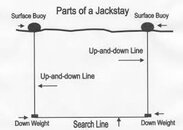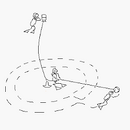We have a new voluntary underwater search and recovery team. We help the police with time consuming searches that are no longer urgent.
We were practicing at a site recently that had a gently sloping bottom 0->4m that then abruptly deepened. There was a steep slope down to 14m. A parallel search pattern with the rope tender walking along the shore was used. The rope however dragged along the ridge causing major silting (and guess where that silt was then heading to...) and it caught every single stone on the shallower already searched area.
How do you solve these issues? Do you have another diver following the ridge and guiding the rope, or are you using floaty polypropylene line instead of nylon, or what? What has proved to be the best practice
We were practicing at a site recently that had a gently sloping bottom 0->4m that then abruptly deepened. There was a steep slope down to 14m. A parallel search pattern with the rope tender walking along the shore was used. The rope however dragged along the ridge causing major silting (and guess where that silt was then heading to...) and it caught every single stone on the shallower already searched area.
How do you solve these issues? Do you have another diver following the ridge and guiding the rope, or are you using floaty polypropylene line instead of nylon, or what? What has proved to be the best practice






